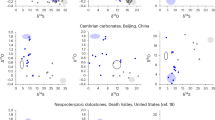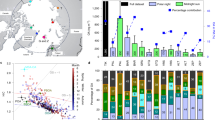Abstract
Sulphate aerosols, particularly micrometre-sized particles of sulphate salt and sulphate-adhered dust, can act as cloud condensation nuclei, leading to increased solar scattering that cools Earth’s climate1,2. Evidence for such a coupling may lie in the sulphate record from polar ice cores, but previous analyses of melted ice-core samples have provided only sulphate ion concentrations, which may be due to sulphuric acid3. Here we present profiles of sulphate salt and sulphate-adhered dust fluxes over the past 300,000 years from the Dome Fuji ice core in inland Antarctica. Our results show a nearly constant flux of sulphate-adhered dust through glacial and interglacial periods despite the large increases in total dust flux during glacial maxima4. The sulphate salt flux, however, correlates inversely with temperature, suggesting a climatic coupling between particulate sulphur and temperature. For example, the total sulphate salt flux during the Last Glacial Maximum averages 5.78 mg m−2 yr−1, which is almost twice the Holocene value. Although it is based on a modern analogue with considerable uncertainties when applied to the ice-core record, this analysis indicates that the glacial-to-interglacial decrease in sulphate would lessen the aerosol indirect effects on cloud lifetime and albedo, leading to an Antarctic warming of 0.1 to 5 kelvin.
This is a preview of subscription content, access via your institution
Access options
Subscribe to this journal
Receive 51 print issues and online access
$199.00 per year
only $3.90 per issue
Buy this article
- Purchase on Springer Link
- Instant access to full article PDF
Prices may be subject to local taxes which are calculated during checkout



Similar content being viewed by others
References
Jansen, E. et al. in Climate Change 2007: The Physical Science Basis (eds Solomon, S. et al.) 433–498 (Cambridge Univ. Press, 2007)
Forster, P. et al. in Climate Change 2007: The Physical Science Basis (eds Solomon, S. et al.) 129–234 (Cambridge Univ. Press, 2007)
Wolff, E. W. et al. Southern Ocean sea-ice extent, productivity and iron flux over the past eight glacial cycles. Nature 440, 491–496 (2006)
Lambert, F. et al. Dust climate couplings over the past 800,000 years from the EPICA Dome C ice core. Nature 452, 616–619 (2008)
EPICA community members. Eight glacial cycles from an Antarctic ice core. Nature 429, 623–628 (2004)
Andreae, M. O. et al. Internal mixture of sea salt, silicates, and excess sulfate in marine aerosols. Science 232, 1620–1623 (1986)
Bodhaine, B. A. Aerosol absorption measurements at Barrow, Mauna Loa and the South Pole. J. Geophys. Res. 100 (D5). 8967–8975 (1995)
Iizuka, Y., Hondoh, T. & Fujii, Y. Na2SO4 and Mg2SO4 salts during the Holocene period derived by high-resolution depth analysis of a Dome Fuji ice core. J. Glaciol. 52, 58–64 (2006)
Iizuka, Y. et al. A relationship between ion balance and the chemical compounds of salt inclusions found in the GRIP and Dome Fuji ice cores. J. Geophys. Res. 113, D07303 (2008)
Legrand, M. R., Lorius, C., Barkov, N. I. & Petrov, V. N. Vostok (Antarctica) ice core: atmospheric chemistry changes over the last climatic cycle (160,000 years). Atmos. Environ. 22, 317–331 (1988)
Iizuka, Y. et al. The rates of sea salt sulfatization in the atmosphere and surface snow of inland Antarctica. J. Geophys. Res. 117, D04308 (2012)
Röthlisberger, R. et al. Nitrate in Greenland and Antarctic ice cores: a detailed description of post-depositional processes. Ann. Glaciol. 35, 209–216 (2002)
Kaufmann, P. et al. Ammonium and non-sea salt sulfate in the EPICA ice cores as indicator of biological activity in the Southern Ocean. Quat. Sci. Rev. 29, 313–323 (2010)
Iizuka, Y. et al. Constituent elements of insoluble and nonvolatile particles during the Last Glacial Maximum of the Dome Fuji ice core. J. Glaciol. 55, 552–562 (2009)
Sakurai, T. et al. The chemical forms of water-soluble microparticles preserved in the Antarctic ice sheet during Termination I. J. Glaciol. 57, 1027–1032 (2011)
Delmonte, B. et al. Aeolian dust in East Antarctica (EPICA-Dome C and Vostok): provenance during glacial ages over the last 800 kyr. Geophys. Res. Lett. 35, L07703 (2008)
Röthlisberger, R. et al. Limited dechlorination of sea salt aerosols during the last glacial period: evidence from the European Project for Ice Coring in Antarctica (EPICA) Dome C ice core. J. Geophys. Res. 108, 4526 (2003)
Manktelow, P. T., Carslaw, K. S., Mann, G. W. & Spracklen, D. V. The impact of dust on sulfate aerosol, CN and CCN during an East Asian dust storm. Atmos. Chem. Phys. 10, 365–382 (2010)
Quinn, P. K. & Bates, T. S. The case against climate regulation via oceanic phytoplankton sulphur emissions. Nature 480, 51–56 (2011)
Charlson, R. J., Lovelock, J. E., Andreae, M. O. & Warren, S. G. Oceanic phytoplankton, atmospheric sulphur, cloud albedo, and climate. Nature 326, 655–661 (1987)
Penner, J. E. et al. in Climate Change 2001, Working Group I: The Scientific Basis (eds Houghton, J. T. et al.) 289–348 (Cambridge Univ. Press, 2001)
Fujii, Y. et al. 210-year ice core records of dust storms, volcanic eruptions and acidification at Site-J, Greenland. Mem. Natl Inst. Polar Res. Spec. Issue 54, 209–220 (2001)
Winckler, G. et al. Covariant glacial-interglacial dust fluxes in the equatorial pacific and Antarctica. Science 320, 93–96 (2008)
Tsai, I. C. et al. Sulfur cycle and sulfate radiative forcing simulated from a coupled global climate-chemistry model. Atmos. Chem. Phys. 10, 3693–3709 (2010)
Lohmann, U. & Feichter, J. Global indirect aerosol effects: a review. Atmos. Chem. Phys. 5, 715–737 (2005)
Masson-Delmotte, V. et al. Past and future polar amplification of climate change: climate model intercomparisons and ice-core constraints. Clim. Dyn. 26, 513–529 (2006)
Watanabe, O. et al. General tendencies of stable isotopes and major chemical constituents of the Dome Fuji deep ice core. Mem. Natl Inst. Polar Res. Spec. Issue 57, 1–24 (2003)
Fujii, Y., Kohno, M., Matoba, S., Motoyama, H. & Watanabe, O. A 320 k-year record of microparticles in the Dome Fuji, Antarctica ice core measured by laser-light scattering. Mem. Natl Inst. Polar Res. Spec. Issue 57, 46–62 (2003)
Acknowledgements
We thank all members of the JARE and the Ice Core Consortium for work at Dome Fuji; T. Takemura, R. Kudo, Y. Fujiyoshi and T. Aoki for comments on radiative forcing of aerosols; H. Ohno and T. Sakurai for comments on microparticles in the Dome Fuji ice core; K. Goto-Azuma, T. Kuramoto and H. Yamada for data management of ion and dust concentrations in the Dome Fuji ice core; and Y. Fujii for data on ion concentrations in the Site J firn core, used to calculate sulphate salts. Y.I. thanks M. Furusaki for help with EDS analyses and J. Nelson for help with revising the manuscript. This study was supported by Creative Scientific Research (grant number 14GS0202), Young Scientists (A) (grant number 23680001) and Scientific Research (S) (grant number 21221002), provided by the Ministry of Education, Culture, Sports, Science and Technology (MEXT), the Japan Society for the Promotion of Science (JSPS) and the Grant for Joint Research Program of the Institute of Low Temperature Science, Hokkaido University.
Author information
Authors and Affiliations
Contributions
Y.I. ran the experiments and analysed data on statistical methods. Y.I., R.U., T.S, H.M. and T.H. discussed the results and commented on the manuscript. T.M. and M.H. provided the dust and ion data. Y.I. and R.U. wrote the paper. Y.I., H.M. and T.H. provided financial resources.
Corresponding author
Ethics declarations
Competing interests
The authors declare no competing financial interests.
Supplementary information
Supplementary Information
This file contains Supplementary Figures 1-5, Supplementary Methods and additional references. (PDF 1896 kb)
Supplementary Data
This file contains Supplementary Data. (XLS 259 kb)
Rights and permissions
About this article
Cite this article
Iizuka, Y., Uemura, R., Motoyama, H. et al. Sulphate–climate coupling over the past 300,000 years in inland Antarctica. Nature 490, 81–84 (2012). https://doi.org/10.1038/nature11359
Received:
Accepted:
Published:
Issue Date:
DOI: https://doi.org/10.1038/nature11359
This article is cited by
-
Homogeneous sulfur isotope signature in East Antarctica and implication for sulfur source shifts through the last glacial-interglacial cycle
Scientific Reports (2019)
-
Sources and elemental composition of summer aerosols in the Larsemann Hills (Antarctica)
Environmental Science and Pollution Research (2015)
Comments
By submitting a comment you agree to abide by our Terms and Community Guidelines. If you find something abusive or that does not comply with our terms or guidelines please flag it as inappropriate.



